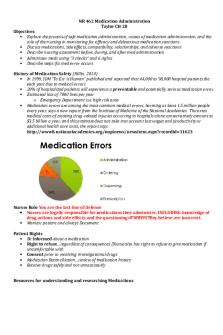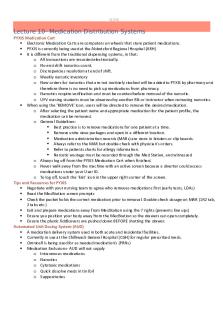Medication Administration Part One PDF

| Title | Medication Administration Part One |
|---|---|
| Course | Medical Assistant |
| Institution | High School - USA |
| Pages | 4 |
| File Size | 283.8 KB |
| File Type | |
| Total Downloads | 28 |
| Total Views | 148 |
Summary
Part One of Medication Administration for Medical Assistant Certification....
Description
Medication Administration Oral •Topical •Vaginal •Rectal •Inhalation •Injection •First Step –Always check the order, making sure you can clearly read the order and that you completely understand what is being ordered •Second Step –Ensure patient does not have an allergy to the ordered medicine •Third Step –Check order again, and check the ten rights Safeguards for Administration of Medications •Three Befores –Medications must be checked three times before administration: ●Before medication is removed from the medication cabinet ●Before medication is poured, drawn up into a syringe, or placed into a medication cup ●Before medication is returned to the cabinet •Ten Rights –Six rights to make sure of each time you administer a medication: 1
1.Right patient 2.Right medication 3.Right dosage 4.Right route 5.Right time 6.Right documentation –Four additional rights to consider when you administer a medication: 1.Right patient education 2.Right to refuse (the patient’s right to refuse a medication) 3.Right assessment 4.Right evaluation Medication Administration • –Medications by intravenous (IV) fluids –Chemotherapy drugs or narcotics •Oral Medication Administration –Swallowed –Enters tissues of gastrointestinal system –Rapidly absorbed into circulatory system and carried to the cells of the body –Can be pills, syrups, or other liquids –Liquid medications ●Suspensions, emulsions, elixirs, syrups, solutions –Equipment for dispensing liquid medication ●Calibrated cups, spoons, droppers, syringes
–Educate patient on proper measurement of these medications –Sublingual medications ●Held under the tongue to diffuse through the tissues and into the bloodstream –Buccal medications ●Placed between the patient’s cheek and gums for absorption through the tissues into the bloodstream • Inhalation Medication Administration –Dispensed into the respiratory tract –Absorbed quickly from the respiratory system into the bloodstream –Equipment includes the metered-dose inhaler (MDI) and the nebulizer ●Medical assistant trains patient to use ●Nebulizer delivers the medication more deeply into the respiratory system •Topical Medication Administration –Application to mucous membranes ●Eyedrops, eardrops, and nose drops ●Eye ointments ●Vaginal creams ●Rectal and vaginal suppositories ●Sterile douche solutions – ’ your own skin
–When administering ointment: ●Clean area with soap and water ●Apply ointment in a thin layer, using cotton swab or tongue depressor –When administering ointment: ●In some instances, after topical drug applied, area must be covered with sterile gauze to keep it clean ●When ointment reapplied, old ointment should be removed before new layer of ointment is applied –If medication is a liquid, shake bottle well before applying it as directed – e •Transdermal patch –A patch on the skin releases medication slowly over time. –Used for hormones, antinausea drugs, pain relievers, and cardiac medications –It is important to wear gloves when you remove the backing on the patch so as not to get any of the medication on your own skin –Rotate location of patch to help prevent skin breakdown •Parenteral Medication Administration –Administration outside gastrointestinal tract, usually by injection ●Intramuscular ●Subcutaneous ●Intradermal ●Intravenous...
Similar Free PDFs

Medication Administration
- 3 Pages

Medication Administration
- 6 Pages

Chapter 31 Medication Administration
- 18 Pages

Chapter 31 Medication Administration
- 27 Pages

Test 1 Medication Administration
- 9 Pages

Chapter 35 Medication Administration
- 16 Pages
Popular Institutions
- Tinajero National High School - Annex
- Politeknik Caltex Riau
- Yokohama City University
- SGT University
- University of Al-Qadisiyah
- Divine Word College of Vigan
- Techniek College Rotterdam
- Universidade de Santiago
- Universiti Teknologi MARA Cawangan Johor Kampus Pasir Gudang
- Poltekkes Kemenkes Yogyakarta
- Baguio City National High School
- Colegio san marcos
- preparatoria uno
- Centro de Bachillerato Tecnológico Industrial y de Servicios No. 107
- Dalian Maritime University
- Quang Trung Secondary School
- Colegio Tecnológico en Informática
- Corporación Regional de Educación Superior
- Grupo CEDVA
- Dar Al Uloom University
- Centro de Estudios Preuniversitarios de la Universidad Nacional de Ingeniería
- 上智大学
- Aakash International School, Nuna Majara
- San Felipe Neri Catholic School
- Kang Chiao International School - New Taipei City
- Misamis Occidental National High School
- Institución Educativa Escuela Normal Juan Ladrilleros
- Kolehiyo ng Pantukan
- Batanes State College
- Instituto Continental
- Sekolah Menengah Kejuruan Kesehatan Kaltara (Tarakan)
- Colegio de La Inmaculada Concepcion - Cebu









